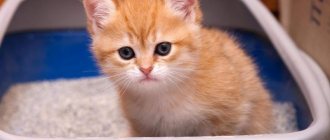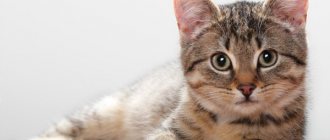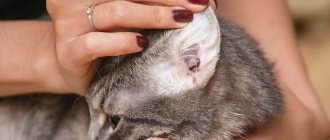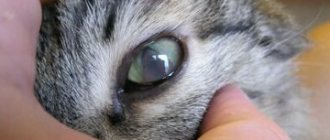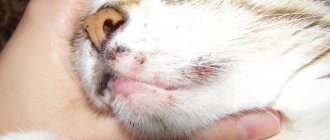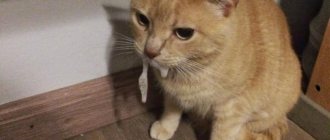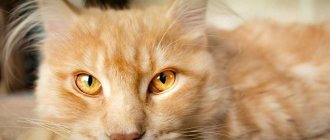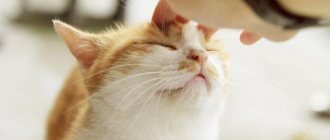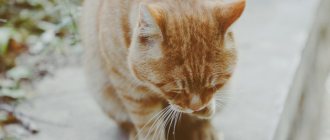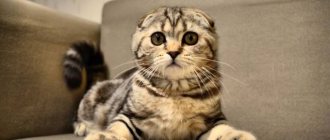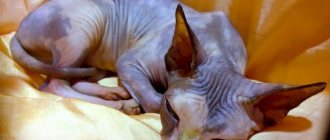It is not difficult for an attentive owner to notice changes in the physical condition of his cat. Mood, behavior, and appetite may change. You should always be attentive to why a cat snorts, breathes through its mouth and sneezes. Sniffling cannot be ignored; it may also indicate a cold or other serious illness.
If a cat has a stuffy nose, he constantly keeps his mouth open, his throat becomes inflamed, and dangerous bacteria enter the body . If such symptoms occur, the most correct decision of the animal owner is to go with the pet to a specialist at a veterinary clinic.
Causes of nasal congestion?
Pets, particularly cats, are susceptible to many infectious diseases; they can catch colds due to a draft or resting on a cold floor. Diseases can be infectious or respiratory. If a cat sniffles through its nose, the reasons may be related specifically to the disease , the onset of an inflammatory process in the mucous membrane.
Rhinitis, rhinotracheitis, and the presence of feline herpes can be diagnosed by a veterinarian. He will tell you how to clean a cat’s nose to make breathing easier, and he will tell you how to treat the disease.
ATTENTION! With nasal congestion, it is difficult for a cat to assess its surroundings, because this organ is of great importance for orientation in space, finding food, and recognizing danger.
When an animal's nose is clogged and grunts, its existence is filled with a feeling of discomfort. And the owner is looking for an answer on how to wash a kitten or an adult pet’s olfactory organ. But first you need to establish the cause of the malaise:
- Inflammation in the nose can begin due to a viral-bacterial disease.
- Sometimes the cause is a parasitic disease.
- A cat may breathe poorly due to rhinitis, sinusitis, or rhinotracheitis.
- If the kitten cannot breathe through its nose, it may have become hypothermic on a cold floor or in a draft.
- The mucous membrane rots due to damage by various pathogenic and opportunistic microorganisms, which, under favorable conditions, especially develop their activity.
If a runny nose accompanies nasal congestion, chronic sluggish rhinitis is most likely due to a decrease in immune potential.
IMPORTANT! Particularly dangerous causes of nasal congestion are cat diseases such as calcivirosis, peritonitis, leukemia, viral pneumonia, feline herpes, and purulent conjunctivitis. Therefore, there is no need to hesitate to visit the veterinarian and self-medicate.
In most cases, a furry pet can be cured at home, but only with a professional diagnosis of the disease and treatment from a veterinarian . The nose becomes very clogged with helminthic infestation, when parasites in the lungs provoke inflammation in the respiratory tract of the body. In this case, it is not enough to put drops in the nose for a runny nose and wait for relief; first you need to get rid of the helminths.
If a cat does not breathe through its nose, it may have a severe allergy to hot steam, household chemicals, pollen, and chemicals .
Allergic reactions are typical for purebred cats, but they can be an individual feature of even a domestic animal. At the same time, the cat may have noticeable discharge, like a runny nose, the pet sneezes and snorts.
Prevention
In order not to be subsequently tormented by questions about why the kitten sniffles and always has a snotty nose, and also what to do if the cat sniffles through its nose when breathing, you should take preventive measures in advance. How to make sure that your pet does not suffer from a runny nose and nasal congestion, and that colds avoid it?
Vaccination
Anemia in cats: symptoms and treatment, causes
Vaccination is a generally recognized effective method of combating viruses. Timely vaccination will protect the animal from various types of ailments.
Despite the fact that complex vaccines for cats are available for sale in veterinary pharmacies, it is not recommended to use them yourself.
Avoid hypothermia
One of the main causes of nasal congestion is hypothermia. An animal may be exposed to hypothermia during a sudden change in temperature or when exposed to a draft. A pet, just like a person, needs comfortable living conditions that will allow it to protect itself from hypothermia.
Balanced diet
A balanced diet is another important preventive measure. To maintain strong immunity, the animal’s body must regularly receive a sufficient amount of necessary elements. There are 2 options for feeding a cat - give the animal high-quality food or include natural products in the diet.
Note! Experts prohibit putting food from the table into your pet's food bowl. It can harm his health, even if the cat eats it with pleasure.
Elimination of allergens
Cats have some tendencies to allergic reactions, so it is not worth testing the strength of their body to various irritants. It is highly not recommended to use cosmetics or chemicals (including cleaning agents) if there is a pet nearby. If suddenly a cat, being near any household chemicals, begins to feel unwell, then it needs to be isolated.
In addition, you need to make sure that the cat does not catch any virus. Even cats that do not leave the house can become infected. Viruses or infections are transmitted to an animal through shoes or clothing. Therefore, the pet should be protected from contact with dirty shoes, as well as with the unwashed hands of people coming into the house.
Responsibility for a pet lies with its owner
When treating at home, you must remember that if a cold is not completely cured, its symptoms may return, which will lead to a chronic disease. In this case, repeated treatment will be much more difficult for both the pet and the owner.
The owner must be aware of his responsibility for the pet: follow the rules of keeping and nutrition, periodically see a veterinarian, and simply monitor its behavior. If necessary, be sure to seek help from specialists.
Features of breathing problems in kittens
If a kitten’s nose is not breathing, what to do and how to treat it? Veterinarians will answer this question competently. Due to its age, a kitten does not yet have a developed immune system; it is easily susceptible to infection by viral, parasitic, and bacterial diseases. Diseases are caused by viruses, fungi, and pathogenic organisms. Even in the womb, the baby can be affected by a virus or bacteria .
INTERESTING! The owner of a small cat should be attentive to the living conditions of the animal. The baby may get sick due to low temperature in the house or hypothermia.
Also, breathing complications are caused by dirt in the nose and foreign objects . When the cat breathes through its mouth, without a nose, you can examine its olfactory organ for contamination.
Causes of runny nose in cats and kittens, treatment of rhinitis at home with drops and other means
A runny nose in a cat is an unpleasant phenomenon. The inability to breathe freely causes the animal a lot of inconvenience, because the sense of smell for it is the most important factor in its existence. That is why, to alleviate the pet’s condition, it is necessary to solve this problem as quickly as possible. Before treating rhinitis in cats, you need to find out why the nose is clogged.
What is a runny nose or rhinitis?
A runny nose is an inflammation of the nasal mucosa, which is accompanied by mucopurulent discharge (snot) and sneezing. A cat's nose is more sensitive than a human's.
Thanks to this, by sniffing, the animal can determine the location of an object even at a considerable distance.
Cats' nasal canals are narrow, and any swelling, even slight swelling due to inflammation, causes partial or complete blockage.
Despite the seeming frivolity of rhinitis, it poses a serious danger for members of the cat family. The nasal passages perform 2 functions: cleansing and warming.
If their patency is impaired, insufficiently warmed air enters the animal’s lungs, which can lead to hypothermia.
In addition, internal organs begin to experience a lack of oxygen, the cat’s general well-being suffers, motor activity decreases, interest in food disappears, and dehydration develops. An untreated runny nose can become chronic.
Causes of runny nose in cats and kittens and methods of treatment at home
In cats, the nose can be stuffy due to foreign objects entering it, respiratory allergosis, infections of viral, bacterial and fungal etiology, parasitic diseases, and neoplasms. Congestion can also be a consequence of the structural features of the nose, which are found in representatives of some cat breeds.
Foreign object in the nasal passages
Adult cats are very careful; they rarely inhale small objects - beads, feathers, etc., which cannot be said about kittens.
With the help of mucus, the cat's body tries to get rid of the foreign body and, as a rule, it succeeds. However, sometimes you cannot do without veterinary help.
It is better not to try to remove a stuck object yourself at home. Inept actions can harm the animal; it is better to entrust this to a veterinarian.
Respiratory allergosis
If a cat’s immune system is sensitive to any allergen, upon contact with it, the nasal mucosa swells, mucus is released from it, tears flow from the animal, and it constantly sneezes.
Treatment of allergic rhinitis is primarily aimed at eliminating the factor that provoked the problem. If the allergy is caused by a new product or medicine, you can do it at home.
In other cases, diagnosis is carried out in a veterinary clinic.
Viral infection
The most common infections of viral etiology, accompanied by nasal congestion and discharge, include:
- calicivirus;
- feline herpes;
- infectious enteritis;
- cowpox;
- leukemia;
- viral immunodeficiency;
- reovirus.
Treatment of these diseases is complicated by the fact that their causative agents are resistant to the action of drugs. The main efforts are aimed at maintaining the body’s own defenses and eliminating secondary infections.
Treatment of the disease includes:
- the use of immunostimulating and antiviral medications for systemic (Roncoleukin, Immunofan, Interferon) and local use (nasal drops Fosprenil, Maxidin, Derinat);
- nasal rinsing;
- use of antibiotics when purulent exudate appears.
Bacterial infection
It happens that a runny nose in an animal is caused by infections of bacterial etiology, the sources of which are chlamydia, mycoplasma, pasteurella, and staphylococcus.
The main symptom of bacterial damage to a cat’s body is thick yellow or green discharge from the nose. Antibiotics (Sinulox, Baytril, Amoxiclav, Gentamicin) will help cure your pet.
It is possible to use more than one antibacterial agent. Nasal drops (Isofra, Polydexa) are also prescribed.
Fungal infection
In representatives of the cat family, infections of fungal etiology are quite rare. The most common are aspergillosis and cryptococcosis. Depending on the fungi present in the body, the pet behaves in a certain way.
If rhinitis has reached a chronic stage and the disease progresses slowly, nasal discharge will appear periodically or during sleep. If the disease is acute, nasal mucus causes the formation of crusts that clog the nose.
The cat must be treated with antifungals (Itraconazole). In a veterinary clinic, intravenous infusions of antifungal solutions (Clotrimazole) are given.
Worm infestation
Parasites can also cause runny noses and sneezing in kittens and adult animals. The addition of a cough may indicate infection with nematodes or roundworms (for example, roundworms).
To treat helminthic infestations, anthelmintic drugs with different active substances are used, most often with combined action (Milbemax, Drontal, Advocate, Azinox, Vermidin, Helmimax, etc.).
Polyps and tumors in the nose
Polyps are one of the types of benign neoplasms in the nasal cavity. They are harmless, but prevent the pet from breathing freely. Under unfavorable circumstances, they can provoke retention of secretions and dead epithelium, which will lead to active reproduction of pathogenic microflora. Large polyps can block the lumen of the nostrils.
Difficulty breathing can also be caused by a malignant tumor. In young pets, such formations are found relatively rarely. Most often, 2 types of neoplasms are detected in representatives of the cat family: lymphoma and adenocarcinoma. If a second formation is detected, the animal’s likelihood of survival is much less.
Polyps are removed surgically. Unlike adenocarcinoma, lymphoma responds well to chemotherapy and radiation. Surgery does not provide a 100% guarantee of recovery, since malignant neoplasms are prone to metastasis.
Anatomical features of a particular animal
Representatives of some cat breeds are prone to runny noses due to the anatomical features of their nose. This group includes Persians, Exotics and Burmese. They suffer from nasal congestion more often than others.
Due to the short nasal passages in the cold season, the inhaled air does not have time to heat up.
The only way to protect these breeds from runny noses is to prevent their bodies from getting too cold during the fall and winter months.
Features of feeding and keeping a cat with rhinitis
When your pet is sick, it is recommended to follow the following care rules:
- Carry out wet cleaning daily in the room where the animal is located.
- Wash your cat's bed and toys and wash bowls as often as possible.
- Place the cat in a draft-free room. It is also necessary to properly humidify the air using a humidifier. If you don't have one, you can place an open container of water next to the cat's bed. The liquid will gradually evaporate, humidifying the air. To facilitate breathing and enhance the protective function of the nasal mucosa, you must periodically bring the animal into the bathroom, after filling the bath with hot water.
- Regularly remove crusts around the eyes and nose. This can be done using decoctions of medicinal herbs (chamomile, St. John's wort) prepared at home, or pharmaceutical preparations - boric acid, previously diluted with water.
As for the diet of a sick pet, it does not require any changes, especially since in the early stages of the disease he does not lose his appetite. The only thing that is recommended to do is analyze your diet. To successfully fight a runny nose, an animal needs a lot of vitamins. Food for a cat should be warm and crushed, and she should always have clean, fresh water (also warm) in her drinking bowl.
Source: https://MurKoshka.ru/zdorovye/preparaty/kapli-v-nos-dlya-koshek.html
Cat has a runny nose
Often cat owners are faced with a pet disease such as rhinitis . The cat suffers from a runny nose and a stuffy nose, because it loses its unique ability to accurately and quickly navigate the environment and recognize danger. What manifestations of rhinitis can be noticed?
- The animal not only has difficulty breathing through its nose, it cannot run or play calmly. It also becomes more lethargic, detached, loses appetite, and looks depressed.
- You can see the cat scratching its nose with its paw, fiddling with it, trying to clear it of congestion.
- Sometimes the temperature rises, even up to 39 degrees. If you touch your pet's nose, you can notice how hot it has become.
- Another sign of rhinitis can be conjunctivitis. It is necessary to wash the animal’s eyes so as not to aggravate the inflammation.
How to cure a runny nose in a kitten?
The kitten's immune system is imperfect, so babies are prone to runny nose. Most often, this is a symptom of an incipient serious illness.
The inflammatory process affecting the nasal cavity is called rhinitis. The body tries to remove mucus from the nose, which contains dirt, toxins and pathogens.
When a pet has a runny nose, it is difficult to breathe, it sneezes, rubs the bridge of its nose with its paws, and it requires veterinary care.
Causes
A runny nose in kittens occurs for the following reasons:
- Dampness and drafts. You should not over-ventilate the room and take your pet out for a walk in humid or damp weather.
- Feeding a supercooled delicacy, such as milk from the refrigerator or frozen fish.
- Sudden temperature changes. During the transition period, when the heating is turned off, it is necessary to provide the kitten with heating. In hot weather, you should not leave your baby in the air conditioner area.
- Allergic reaction. The cub may react inappropriately to smoke, pollen of angiosperms, perfumes, and solvents. Choch provokes the smell of new furniture or unusual food. In addition to a runny nose, profuse salivation may occur.
- Infectious pathologies. Most infectious diseases are accompanied by rhinitis. Rhinotracheitis, Calcivirosis, and Panleukopenia pose a threat to life.
- Congenital anomalies. A kitten born with a crooked nose constantly sneezes. He has continuous leakage.
With Calcivirosis, conjunctivitis develops along with a runny nose
The most dangerous diseases
A runny nose is a symptom of the most dangerous viral diseases:
- Calcivirosis.
- Rhinotracheitis.
- Panleukopenia.
Calcivirosis
An extremely contagious viral infection. Characterized by fever, rhinitis and stomatitis. Kittens taken from their mothers become ill.
Those who recover gain lifelong immunity, but become spreaders of the virus. If the disease is not treated, 30% of clinically ill patients die.
Ulcerative stomatitis is considered a striking additional symptom. This makes it difficult for the kitten to swallow. He refuses to eat and loses weight. Gingivitis occurs, characterized by inflammation of the gums. A runny nose is accompanied by a cough, and bronchopneumonia develops. If pulmonary edema occurs, the kitten dies.
Rhinotracheitis
Rhinotracheitis is caused by the herpes virus. Develops rhinitis, conjunctivitis and tracheitis. The kitten cries and sneezes, having recovered from the disease, it becomes a carrier of the virus, gaining lifelong immunity. Hypothermic cubs and unvaccinated individuals become ill. Unbalanced nutrition and overcrowding increases the risk of epizootics.
The signs of the disease are similar to the symptoms of Calcivirosis, but the ulcers do not appear on the mucous membrane of the mouth, but on the cornea of the eye. In kittens, necrosis of nasal tissue and bone resorption are observed.
Rhinotracheitis
Panleukopenia
Panleukopenia is a dangerous disease with high mortality. Survivors within 100 hours become reservoirs of Parvovirus. Contagium is transmitted by blood-sucking exoparasites.
There is no placental barrier; kittens receive the virus in utero. Intermittent fever is characteristic. First, body temperature rises 2 °C above normal, and after 2 days it drops 1 °C below the limit.
The pulmonary variant of panleukopenia is characterized by purulent discharge from wear and tear and eyes. Cloudy films and hemorrhages appear on the mucous membranes. The mortality rate is, on average, 50%.
Panleukopenia
Antimicrobial therapy
Use the following means:
- Antiviral. On the first day of illness, Vitafel is used in the form of immunoglobulin or serum containing antibodies against Panleukopenia, Rhinotracheitis and Calcivirosis. Late passive immunization is ineffective: viruses fade into the background, and the fight against secondary microflora becomes urgent.
- Are common. Immunostimulants that stimulate the immune response are indicated. The following drugs are in demand:
- Cycloferon.
- Immunofan.
- Phosphprenyl.
- Gamavit.
- Derinat.
- Antibiotics. Necessary to prevent the development of secondary microflora that causes a runny nose, lacrimation and other symptoms.
Symptomatic treatment
To eliminate signs of rhinitis, use nasal drops:
- Anandin.
- Maxidin.
- Thymogen.
If there is no positive effect, the following medications are allowed for use under the supervision of a veterinarian:
- Naphthyzin.
- Dioxidine.
- Nazivin.
- Galazolin.
Nasal drops
Treatment of rhinitis
A runny nose and inflammation of the mucous membranes should be treated promptly ; there is no need to wait for complications for the pet to become deaf or for the inflammation to spread to other respiratory organs.
- If rhinitis occurs due to an infection, bacterial or viral, the veterinarian prescribes antibiotics and antibacterial drugs, taking into account the animal’s age and breed. It is important to strictly adhere to the instructions and carry out the course of treatment to the end, even if there is no discharge and the nose can breathe freely.
- The course of treatment for rhinitis may include antipyretic, anti-inflammatory, and sedative drugs.
- Sometimes the veterinarian recommends rinsing the animal’s nose to ease its breathing and general condition.
- Inhalations with essential oils are effective for rhinitis; you just need to strictly follow the dosage of oil drops. The nose is also warmed up with warm sand or salt wrapped in a clean cloth.
- If your pet has dry skin around its nose, you can constantly moisturize it with baby cream or Vaseline.
If you need to clear your nose, you should act very carefully and carefully , following the advice of experts. Wounds can not only cause pain, but also become a source of infection . You can clean the crusts with a damp cotton swab.
A runny nose in a cat: symptoms and causes of rhinitis, how and how to treat a cat
Cat runny nose is not the same as rhinitis in humans. If the animal begins to sneeze and discharge appears in the nose, then there is a possibility of developing serious infections. There is no point in waiting for everything to go away on its own. Rhinitis refers to an inflammatory process in your pet's body and must be treated.
Causes and symptoms
Sneezing and discharge in an animal can be caused by infectious and non-infectious causes. Depending on this, you need to build treatment.
Colds and hypothermia
Cats have a very high immunity, and colds - so frequent and even commonplace for humans - are rather an exception to the rule for an animal. Colds and runny noses are more common in homeless cats during periods of cold and rain. Colds occur for several reasons:
- The room is too damp, drafty.
- High humidity.
- Lack of vitamins, poor nutrition.
- Sudden temperature changes.
- The animal is hypothermic or wet (this can happen if the cat, for example, is not dried well after bathing).
Symptoms that will indicate a cold:
- Dry or, conversely, hot nose.
- Hair loss or dullness.
- Great lethargy.
- The cat sleeps for a long time or gets very scared of something that didn’t bother her before.
- Weakness (the animal stands well on its feet, but is apathetic), increased fatigue.
- Decreased appetite.
With a cold, breathing becomes difficult, the snot is clear and not viscous. The cat sneezes and coughs heavily, and the eyes may water. If discharge sticks to the muzzle or crusts appear, this means that the disease is becoming serious and may progress to the pathological stage.
An animal can breathe through its mouth to facilitate the process of obtaining oxygen, but if this happens constantly and the nose is not involved, you should immediately consult a doctor.
Allergy
If the animal sneezes, tries to constantly rub its eyes and nose, and discharge of a transparent texture appears from the eyes, most likely, we are talking about an allergic rhinitis. The snot in this case is liquid, transparent in color (odorless), and may be accompanied by swelling and dermatitis. Breathing is impaired and itching is likely.
REFERENCE
Cats can develop allergies to a certain product. After consultation with a veterinarian and tests, he will have to be ruled out. There may be allergies to medications, pollen, house plants, and even household items. Most often, the animal reacts to the irritant after several hours, but symptoms can appear several days after encountering the allergen.
Fungi and bacteria
Human ARVI, most often, is not transmitted to cats, but if the disease is caused by certain fungi and bacteria, then both the owner and the pet can become infected with a runny nose.
A bacterial infection is indicated by:
- unpleasant smell of discharge and its yellow-green color;
- accumulation of pus in the corners of the eyes or over the entire surface;
- snot from the nose and tears from the eyes;
- constant sneezing and coughing;
- the animal constantly swallows, this is due to the fact that mucus accumulates in the nasopharynx;
- body temperature rises;
- loss of appetite;
- dehydration;
- prolapse of the third eyelid.
Fungal infections overwhelm animals with weak immunity and often the runny nose becomes chronic. An indicator of a bacterial infection is a crust in the nose, which makes breathing very difficult and snot comes out of the nose.
Important! If the polyps have grown, the animal's face will become deformed. This is dangerous because the inflammation spreads to the brain; the symptoms of this are seizures.
about runny nose in cats:
Foreign bodies
Coughing and sneezing may be caused by a cat swallowing a foreign object in its intestines or esophagus. If this happens, the symptoms will be as follows:
- Profuse salivation.
- If a foreign body is in the throat, then coughing and wheezing appear, the tongue turns blue, and the cat may lose consciousness.
- Constant swallowing.
- Vomiting and belching.
- Complete lack of appetite.
- Bloating.
- Lethargy, apathy, drowsiness.
- Diarrhea, constipation.
- Symptoms of general intoxication.
Congenital pathologies
A runny nose can result from birth defects and injuries. For example, a “cleft palate,” that is, disturbances in the structure of the upper jaw and nasal bones, will cause the cat difficulty breathing and wheezing. Injuries to the jaw or head can result in a cleft palate. The bones can become displaced, and all this together will give the animal a chronic runny nose.
Important! If rhinitis does not go away for a long time or occurs periodically, be sure to contact your veterinarian.
With such pathologies, the discharge does not have an unpleasant odor and most often does not affect the general condition of the cat (if the injury is cured and is not life-threatening). To clarify the causes of chronic runny nose, you should contact your veterinarian. He will identify the pathology and tell you whether it is possible to treat it or eliminate the symptoms.
Inflammation (ears, teeth, gums)
A runny nose can be an indicator of inflammation that occurs in the nasopharynx or ears. And it will not go away until the initial inflammation is removed.
Why do cats get ear infections?
- Infections.
- Hypothermia.
- Other specific diseases.
Why gums and teeth can become inflamed:
- Malocclusion.
- Lack of vitamins.
- Caries.
- Tartar.
- Injury.
- Irradiation.
- Virus.
- Chemical poisoning.
With inflammation, the following clinical picture is observed:
- breathing quickens;
- discharge from the eyes becomes watery;
- the animal periodically breathes through its mouth;
- sneezing occurs infrequently;
- purulent snot, gray-green, whitish, yellow, sometimes even with traces of blood;
- loss of appetite.
Other causes of runny nose
Other problems that cause coughing, sneezing and sniffles include:
- Parasites, for example, worms.
- Tumor of the nasopharynx.
- Neoplasms.
- Chronic diseases.
- Infections.
- Stress.
Treatment
Since a runny nose often becomes only an indicator of a viral infection or other inflammation in the body, it will be necessary to treat not so much it as the root cause. It is not always possible to independently find out the true source of the disease. Therefore, it is very important to consult a veterinarian, conduct a diagnosis and follow the treatment plan.
It will be very difficult to cure a stray cat from a runny nose if he is not provided with comfortable conditions: warmth, food, vitamins and scheduled medications.
on how to put drops in a cat's nose:
Colds and rhinitis
If your cat's cold cannot be treated at home, then you need to seek help from a veterinarian. The clinic will examine the cat and prescribe the necessary medications. It is not recommended to use medications without a prescription from a specialist. Typically treatment includes:
- Taking antipyretics if the temperature persists.
- Expectorants.
- Antibiotics.
- Vitamins.
- Droppers (to avoid dehydration).
Drugs used:
- Maxidin. Drop into the nose to stimulate the immune system.
- Anandin. Antiviral and immune system stimulant.
- Naphthyzin together with Dioxidine. Nasal rinsing.
- Galazolin. Drops to ease breathing.
One drop of the drug is instilled into each nostril. The course is from five days to a week. You can rinse your nose with zinc sulfate (2%), boric acid (3%), a mixture of Methanol and fish oil.
Other means: “Maksidin”, “Derinat”.
Important! Never use “human” drops, they can aggravate the situation and cause irritation of the mucous membrane.
Allergic runny nose
Irritation in animals is caused by food and non-food allergens. The most common of them:
- Beef or pork.
- Chicken, chicken eggs.
- Cow's milk.
- Corn, wheat (other cereal grains).
- Potato.
- Carrot.
- Dust.
- Mold.
- Hygiene products, household chemicals.
- Irritant from a flea collar.
To cure an allergy, you need to accurately and in detail describe the symptoms to the doctor; it is advisable to note what exactly the cat reacts to and for how long. They do a blood test and scraping. Antihistamines and corticosteroids are most often used for treatment.
The house needs to be treated with insecticides, and the animal must be isolated from the allergen that causes the reaction. If you cannot immediately find out what exactly is causing the disorder, you must remove as much as possible all household chemicals, medications, cosmetics, etc. The room must be cleaned and ventilated frequently.
If the allergy is accompanied by itching, the doctor will prescribe a special ointment, shampoo or gel. Sometimes steroid hormones and immunotherapy are prescribed (a small amount of the allergen is injected into the blood so that the body gets used to it).
If you have an eating disorder, you need to follow a diet. For example, use hypoallergenic food. When the symptoms go away, the previous foods are returned to the diet, checking the animal’s reaction. If the runny nose recurs, food allergens should be categorically removed from the animal’s food forever.
Viral runny nose
Among viral infections, rhinotracheitis, calicivirosis, mycoplasmosis, chlamydia and other infections cause a runny nose. And although they differ, the treatment regimen is approximately the same for everyone. The main thing is to contact specialists in time. You cannot cure a viral infection on your own; only a veterinarian can prescribe the exact dosage and duration.
Serum or globulin is used to create immunity - the drug VITAFEL, vitamins and probiotics, replacement therapy.
Immunostimulants:
- Roncoleukin.
- Derinat.
- Neovir.
- Gamavit.
Antibiotics are required. They are drunk for at least five days, most often from a week to ten days, one to three times a day.
- Macropen.
- Baytril.
- Neopen.
- Cefazolin.
- and others.
Treatment at home
For treatment at home, nasal drops are used, for example, children's nasal drops - one in each nostril daily.
You can rinse your nose with a hypotonic solution: a teaspoon of sea salt in warm water (half a glass). The mucous membrane is also washed with a solution of tannin (0.5%), soda (1% solution).
Streptocide powder is blown into the nasal cavity or two drops of ecmonovocillin are dripped into each nostril (it is diluted with saline 1:2).
From folk remedies, rinsing with beet juice is suitable: 1 part juice to 3 parts water. Aloe juice from the cut is collected into a pipette and dripped for three days. To rinse, you can use boric acid (draw the liquid into a syringe without a needle, drop it into the nostril).
You can do inhalation: take a bowl of hot water, drop eucalyptus or other oil into it, and place the container near the animal.
Prevention of runny nose in cats
You can prevent your pet from sneezing and coughing by taking a number of measures:
- Make sure that there are no drafts in the room;
- Provide your cat with a balanced diet (with vitamins and minerals);
- Make the necessary vaccinations and show the animal to the veterinarian;
- If the animal is dried with a hairdryer, then there is no need to direct the stream towards the muzzle;
- Vaccination. Including from seasonal infections and changing living conditions;
- Deworming (treatment for parasites) using special means;
- Frequent wet cleaning of the premises;
- Isolation of household chemicals from animals.
The primary task during a runny nose is to establish the true causes of the disease (to do this, contact a veterinarian) and improve breathing. The animal can recover only under the close supervision of the owner and with proper care.
Source: https://kotoholik.com/veterinaria/bolezni/nasmork-u-koshki.html
How to make breathing easier?
In this case, you will need special nasal drops that constrict the blood vessels. They should be dripped into each nostril of the nose, treatment will take about a week.
ATTENTION! Before you put drops in your pet's nose, you should first clean it of crusts. You cannot use cosmetics for this purpose that the cat can inhale.
For instillation, only drops for cats are used, no drugs for humans . Medicines for animals have such important additional properties as immunostimulating effects.
When treating kittens, medications are prescribed taking into account their young age. Sometimes even children's drops, such as Pinosol and Protargol, are suitable. You should only drip the number of times indicated in the instructions; an excess of the medicine will not bring any benefit , and there may even be complications.
You shouldn't rely on your intuition when treating your cat's nasal congestion or other health problems. There are videos on special websites that will help you treat your cat competently and safely. In any situation, pet owners should follow the recommendations of veterinarians and breeders who have professionally studied all the features of caring for cats .
The cat’s nose can’t breathe: what to do, treatment
Since the disease often worries kittens, you should assess the situation and make a decision: try to solve the problem yourself or run to the clinic. If the kitten is not vaccinated, most likely it has a viral infection and cannot be treated without the help of a veterinarian.
Be sure to read:
Why does a crust appear on a cat’s nose?
When a vaccinated teenager or adult animal falls ill, you can try to help yourself.
The therapeutic strategy includes the following points:
- Ensuring adequate feeding and proper maintenance. You should use wet food or a complete natural diet, since the pet has difficulty breathing and loses its appetite.
- Treatment of the underlying disease with antimicrobial drugs. In the first days, passive immunization with hyperimmune serum or globulin is indicated. Delayed treatment for 3-5 days is ineffective. The main danger is secondary microflora, which develops against the background of a weakened immune system due to the virus. That's why antibiotics are used. The form of administration - parenteral or external - is determined by the veterinarian. To increase the body's resistance, immunomodulators are prescribed.
- Symptomatic therapy. External preparations are used - solutions or ointments for administration into the nasal cavity. If the disease has spread to the eyes or mouth, special agents are used to treat conjunctivitis and stomatitis. When the allergic nature of the runny nose is diagnosed, the source of irritation is eliminated and antihistamines are used.
What can be the consequences of rhinitis?
An irresponsible cat owner can rely on a miracle and wait for the pet’s runny nose to go away on its own. But congestion and discharge, inflammation associated with colds or allergies, need to be treated and only as prescribed by a doctor.
If an animal does not breathe well, it does not receive the required amount of oxygen. Because of this, appetite and general condition worsen, and the body becomes exhausted. Acute rhinitis, with inactivity, becomes chronic, and it is much more difficult to treat .
What happens if your cat's nasal congestion is not treated?
If rhinitis of viral etiology is not treated, the kitten will die. If he survives, he will acquire immunity and remain a virus carrier for a long time.
If treatment is not timely, the following complications develop:
- bronchitis;
- pneumonia;
- purulent conjunctivitis;
- blepharitis;
- uveitis, panophthalmitis, ulcerative keratoconjunctivitis, resulting in loss of vision;
- gingivitis, ulcerative stomatitis, in which there is a threat of tooth loss, appetite is impaired, and the animal rapidly loses weight.
Be sure to read:
The cat is coughing and wheezing, how to treat it at home
Toxoplasma, chlamydia, secondary microflora affecting the nostrils and eyes of a pet are unsafe for humans.
Preventive measures
What to do to avoid a runny nose in a cat, which can cause its condition to worsen?
- It is necessary to avoid situations during which the cat may become hypothermic or catch a cold.
- Vaccination effectively helps prevent infectious and fungal diseases.
- It is important to increase the animal’s immunity through proper feeding.
- If your pet suffers from allergic reactions, sources of allergy should be excluded from the home environment. The source can even be food of a certain brand and composition.
Causes
It is very important to find out why your cat is sick, because the method of treatment and care depends on this.
- The most common cause is a cold. The site Ko6e4ka.ru reminds you that just because cats have thick and warm fur does not mean that they cannot become hypothermic. The cat could simply drink cold water or take a walk in a draft.
- Allergy. Your cat could walk along the windowsill and smell the blooming flowers, or flowers given for his birthday. This is enough to make you lose your sense of smell for a week. If your cat has an allergy, it is unlikely that he will feel very unwell, but his eyes may become watery.
- Smell of chemicals. Any means for washing dishes, floors, windows, or washing powder can provoke a runny nose attack. In such cases, the cat usually has a very stuffy nose and watery eyes. There is no need to treat such a runny nose; it is enough to ventilate the room. If the cat begins to choke, the nasal mucosa is swollen, or you see a burn on the nose, call a veterinarian immediately, it could be poisoning with toxic fumes!
- Something got in my nose. The cat could have inhaled a grain of sand or other small particle. It scratches the mucous membrane and causes swelling. Such particles come out on their own with a large amount of snot, but if the object was of significant size, it is worth showing the cat to a doctor.
- Neoplasms in the upper respiratory tract.
- Infectious diseases.
- Parasites.
If the cat's condition is normal, she does not lie down all the time, eats well, is cheerful and playful, then you can try to help her yourself. If the animal is very ill, then it is better not to risk it and show it to a specialist.
Types and signs of nasal discharge
- mucopurulent;
- bloody;
Mucous discharge is a clear discharge, quite liquid (not too viscous). Such discharge may be a sign of an allergy and the entry of a fine substance into the animal’s nose, causing mechanical irritation of the mucous membrane. The secretion of the mucous membrane may contain leukocytes and microparticles that cause irritation.
In young kittens, pus in the nasal secretions can appear due to poor care, the absence of a mother, and significant dietary errors.
Transparent discharge flowing from one nostril may be a sign of a foreign object entering the nasal passage. If the object is large or sharp, the discharge may be mixed with blood; if the object is in the sinus for a long time, a bacterial infection may occur. The general condition of the pet is slightly impaired.
Allergic rhinitis is accompanied by frequent sneezing of the animal and the discharge of clear mucous discharge, often in large quantities.
Infection with fungi (most often cryptococcosis), brain tumors that collapse or grow into the nose, and chronic infections caused by bacteria cause the destruction of nasal membranes. This leads to the flow of mucopurulent secretion mixed with blood from one or both nasal passages.
A severe respiratory disease in cats caused by a herpes virus is called rhinotracheitis. It is accompanied by many symptoms: general (lethargy, fatigue, drowsiness, refusal to eat) and specific (purulent discharge from the eyes and nose, sneezing). Pneumonia may develop in weakened animals, and self-abortion may occur in pregnant cats.
Another common infectious disease that is dangerous for cats is calcivirus. It is characterized by copious discharge from the nose and eyes, initially mucous, then serous, then purulent, foul-smelling discharge. The cat begins to develop hypersalivation, fever (up to 40.5 o C), and ulcerations appear on the mucous membranes of the mouth, lips, and tongue. The animal refuses food, diarrhea may develop, followed by constipation.
If pus or blood appears in your cat's nasal discharge, you should definitely show him to a veterinarian. To make it easier for an animal to breathe before going to the hospital, its nasal passages need to be cleared of crusts; this can be done with cotton wool pads and baby oil. You can soak the crusts using saline or boric acid (2% solution can be purchased at the pharmacy).
If a cat has an allergy, you need to try to find out what substance caused it and stop the cat's contact with the allergen. Wet cleaning of the room and humidification of the air will help make nasal breathing easier for your animal; you can take your cat with you to the bathroom. While you take a shower or bathe, the cat will breathe moist air.
